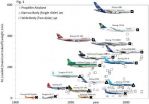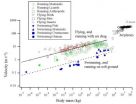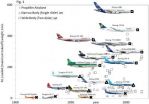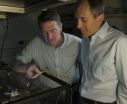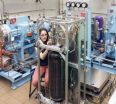(Press-News.org) DURHAM, N.C. -- Researchers believe they now know why the supersonic trans-Atlantic Concorde aircraft went the way of the dodo -- it hit an evolutionary cul-de-sac.
In a new study, Adrian Bejan, professor of mechanical engineering and materials science at Duke University, shows that a law of physics he penned more than two decades ago helps explain the evolution of passenger airplanes from the small, propeller-driven DC-3s of yore to today's behemoth Boeing 787s. The analysis also provides insights into how aerospace companies can develop successful future designs.
The Concorde, alas, was too far from the curve of these good designs, Bejan says. The paper appears online July 22, in the Journal of Applied Physics.
"The evolution of Earth's species occurred on a timescale far too large for humans to witness," said Bejan. "But the evolution of our use of technology and airplanes to transport people and goods has taken place in little more than a single lifetime, making it visible to those who look. Evolution is a universal phenomenon encompassing technology, river basins and animal design alike, and it is rooted in physics as the constructal law."
The constructal law was developed by Bejan in 1996 and states that for a system to survive, it must evolve to increase its access to flow. For example, the human vascular system has evolved to provide blood access to flow through a network of a few large arteries and many small capillaries. River systems, tree branches and modern highway and road networks show the same forces at work, he says.
In the case of commercial aircraft, designs have evolved to allow more people and goods to flow across the face of the Earth. Constructal law has also dictated the main design features needed for aircraft to succeed; the engine mass has remained proportional to the body size, the wing size has been tied to the fuselage length, and the fuel load has grown in step with the total weight.
"The same design features can be seen in any large land animal," said Bejan. "Larger animals have longer lifespans and travel farther distances, just as passenger airplanes have been designed to do. For example, the ratio of the engine to aircraft size is analogous to the ratio of a large animal's total body size to its heart, lungs and muscles."
To apply his theories to airplane design, Bejan teamed up with Jordan Charles, a researcher and development engineer, and Sylvie Lorente, a professor of civil engineering at the University of Toulouse, to mine the historical databases of successful commercial aircraft. As they plotted thousands of statistics including year of introduction, size, cruising speed, engine weight, fuel weight, range, wingspan and fuselage length, many patterns began to emerge.
But two in particular stood out.
In one chart, a clear curve tracks the increasing size of commercial airplanes through nearly a century of aviation. As time moves on, new commercial airliners come in all sizes but the biggest are joined by even bigger models. In another chart, the line that best tracks the relationship of body mass to airplane speeds is nearly identical to mass and speed statistics from various mammals, lizards, birds, insects and more. Evolutionary constraints found in nature, in other words, can be seen at work in the airline industry.
There was, however, one outlier on the chart—the Concorde.
"The Concorde was too far off from the ratios that evolution has produced in passenger jets," explained Bejan, who points out that the doomed aircraft had limited passenger capacity, a low mass-to-velocity ratio, an off-the-charts fuselage-to-wingspan ratio, massive engines and poor fuel economy. "It would have had to adhere to the constructal design rules to succeed."
Bejan said this analysis shows that the aviation industry has done well with its designs over the decades, and that the trends dominating the industry are indeed the most efficient. They also reveal the general design parameters that future passenger aircraft should follow to succeed economically.
"This study gives the rough sketch of what airplane designs will put you in the game," said Bejan. "For design companies, it is money in the bank."
Jose Camberos, research aerospace engineer and lead of design space exploration at the Multidisciplinary Science & Technology Center of the Air Force Research Laboratory at Wright-Patterson Air Force Base in Dayton, Ohio, said that the work will hopefully give the field better insight into where the design of airplanes is going.
"There is definitely an analogy to be understood and articulated to explain why engines and airplanes are sized the way they currently are and how that has evolved," said Camberos, who was not involved with this study. "By looking at the development of aircraft in a larger context in these terms, it may be possible to gain insights into how best to achieve what nature has been able to accomplish already."
INFORMATION:
This research was supported by the National Science Foundation.
CITATION: "The Evolution of Airplanes," A. Bejan, J.D. Charles, S. Lorente. Journal of Applied Physics, July 22, 2014. DOI: 10.1063/1.4886855
Law of physics governs airplane evolution
Constructal Law explains progression of passenger jets, sets guidelines for future aircraft
2014-07-22
ELSE PRESS RELEASES FROM THIS DATE:
The evolution of airplanes
2014-07-22
WASHINGTON D.C. July 22, 2014 -- One of the traditional arguments against Darwinian evolution has been that no one can confirm the process exists because it occurs on a time scale immensely greater than a human lifetime. Adrian Bejan, the J. A. Jones Distinguished Professor of Mechanical Engineering at Duke University, has disagreed with that notion ever since 1996 when he discovered the Constructal Law, a fundamental principle of physics that underlies the evolution of flow systems as they change in design over time.
In a new paper in the Journal of Applied Physics, ...
Bats use polarized light to navigate
2014-07-22
Scientists have discovered that greater mouse-eared bats use polarisation patterns in the sky to navigate – the first mammal that's known to do this.
The bats use the way the Sun's light is scattered in the atmosphere at sunset to calibrate their internal magnetic compass, which helps them to fly in the right direction, a study published in Nature Communications has shown.
Despite this breakthrough, researchers have no idea how they manage to detect polarised light.
'We know that other animals use polarisation patterns in the sky, and we have at least some idea ...
'Comb on a chip' powers new NIST/Caltech atomic clock design
2014-07-22
Researchers from the National Institute of Standards and Technology (NIST) and California Institute of Technology (Caltech) have demonstrated a new design for an atomic clock that is based on a chip-scale frequency comb, or a microcomb.
The microcomb clock, featured on the cover of the inaugural issue of the new journal Optica,* is the first demonstration of all-optical control of the microcomb, and its accurate conversion of optical frequencies to lower microwave frequencies. (Optical frequencies are too high to count;microwave frequencies can be counted with electronics.)
The ...
Mount Sinai scientists and international team shed new light on schizophrenia
2014-07-22
NEW YORK, NY -- As part of a multinational, collaborative effort, researchers from the Icahn School of Medicine at Mount Sinai have helped identify over 100 locations in the human genome associated with the risk of developing schizophrenia, in the largest genomic study published on any psychiatric disorder to date, conducted with 80,000 people. The findings, published online in Nature, point to biological mechanisms and pathways that may underlie schizophrenia, and could lead to new approaches to treating the disorder, which has seen little innovation in drug development ...
P90X? Why consumers choose high-effort products
2014-07-22
Stuck in traffic? On hold for what seems like an eternity? Consumers often face situations that undermine their feelings of control. According to a new study in the Journal of Consumer Research, when a person's sense of control is threatened, they are more likely to seek out products that require hard work.
"Intuitively, it would seem that feeling a loss of control might cause consumers to seek out a product that does NOT require them to exert very much effort. But we find that consumers actually look to products that require hard work to restore their belief that they ...
Fill 'er up: NIST develops prototype meter test for hydrogen refueling stations
2014-07-22
To support the fair sale of gaseous hydrogen as a vehicle fuel, researchers at the National Institute of Standards and Technology (NIST) have developed a prototype field test standard to test the accuracy of hydrogen fuel dispensers. Once the standard is field tested, it will serve as a model for constructing similar devices for state weights and measures inspectors to use.
Three automakers plan to begin selling hydrogen-fueled vehicles to consumers in 2015. The state of California has opened nine refueling stations and is funding the construction of an additional 28 ...
Overdoing it: Multiple perspectives confuse consumers
2014-07-22
Television commercials for luxury vehicles pack a lot in their 30-second running times: the camera offers quick shots of the soft leather upholstery, the shiny colors, the state-of-the-art entertainment system, and the four-wheel drive. But these multiple angles and shifting perspectives have a negative impact on consumer evaluation of products, according to a new study from a Tel Aviv University researcher.
TAU's Dr. Yael Steinhart and her collaborators Yuwei Jiang of Hong Kong Polytechnic University, Rashmi Adaval of Hong Kong University of Science and Technology, and ...
Why do challenging tasks make consumers believe drugs wear off faster?
2014-07-22
Imagine that you have a cup of coffee and sit down to read People magazine. How long do you think the energy boost will last before you reach for another cup? Would you need more caffeine if you tried to read War and Peace? A new study in the Journal of Consumer Research finds that consumers wrongly believe that pharmacological products such as coffee and aspirin lose their effectiveness when they engage in more strenuous activities.
"People make assumptions about how long it takes for products to wear off. For example, they know that cars burn gasoline more quickly ...
Empathy or justice: What makes consumers donate more to charity?
2014-07-22
Have you ever received a request for help and wondered how deserving the recipients are of your donation? This way of thinking may seem inconsistent with your moral values, especially if you consider yourself an otherwise compassionate and empathic person. A new study in the Journal of Consumer Research suggests that moral identity decreases donations when recipients are deemed to be responsible for their plight.
"Our research examines how moral values of empathy and justice have distinct influences on people when they are asked to make donations benefiting others whose ...
I'll have what he's having? How consumers make choices about new products
2014-07-22
Have you found yourself at a fancy restaurant trying to impress new friends or in a foreign country and unsure of what to order? Not wanting to appear foolish, you just go along with everyone else. According to a new study in the Journal of Consumer Research, we're more likely to copy other people's choices when we lack social acceptance or enough information to make an informed decision.
"We suggest that when someone is deciding between options for which their preferences are not well formed, observing the choice of another consumer makes the option chosen by the other ...
LAST 30 PRESS RELEASES:
Cosmic rays streamed through Earth’s atmosphere 41,000 years ago
ACP issues clinical recommendations for newer diabetes treatments
New insights into the connections between alcohol consumption and aggressive liver cancer
Unraveling water mysteries beyond Earth
Signs of multiple sclerosis show up in blood years before symptoms
Ghost particle on the scales
Light show in living cells
Climate change will increase value of residential rooftop solar panels across US, study shows
Could the liver hold the key to better cancer treatments?
Warming of Antarctic deep-sea waters contribute to sea level rise in North Atlantic, study finds
Study opens new avenue for immunotherapy drug development
Baby sharks prefer being closer to shore, show scientists
UBC research helps migrating salmon survive mortality hot-spot
Technical Trials for Easing the (Cosmological) Tension
Mapping plant functional diversity from space: HKU ecologists revolutionize ecosystem monitoring with novel field-satellite integration
Lightweight and flexible yet strong? Versatile fibers with dramatically improved energy storage capacity
3 ways to improve diabetes care through telehealth
A flexible and efficient DC power converter for sustainable-energy microgrids
Key protein regulates immune response to viruses in mammal cells
Development of organic semiconductors featuring ultrafast electrons
Cancer is a disease of aging, but studies of older adults sorely lacking
Dietary treatment more effective than medicines in IBS
Silent flight edges closer to take off, according to new research
Why can zebrafish regenerate damaged heart tissue, while other fish species cannot?
Keck School of Medicine of USC orthopaedic surgery chair elected as 2024 AAAS fellow
Returning rare earth element production to the United States
University of Houston Professor Kaushik Rajashekara elected International Fellow of the Engineering Academy of Japan
Solving antibiotic and pesticide resistance with infectious worms
Three ORNL scientists elected AAAS Fellows
Rice bioengineers win $1.4 million ARPA-H grant for osteoarthritis research
[Press-News.org] Law of physics governs airplane evolutionConstructal Law explains progression of passenger jets, sets guidelines for future aircraft
